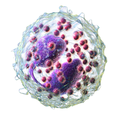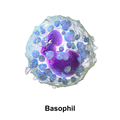Blood smear
Making a blood smear[edit | edit source]
We take blood from the abdomen of the finger or the lateral side of the third or fourth finger of the non-dominant hand, in children from the heel or earlobe. We use disinfection to clean the skin surface. The first drop that appears is wiped with a sterile swab due to the possible content of tissue fluid. We apply the second drop of blood to the degreased slide. Place the drop on one side of the slide (eg to the right) and move the other slide slowly to the drop from the other (left) side. As soon as the glass touches the drop, the blood spreads along the entire edge by capillary action. In a smooth motion, we spread the blood in a thin layer on the glass in the direction from the drop. The smear is then allowed to dry and fixed.
Blood smear (anemia):
Blood smear processing[edit | edit source]
This is a traditional method of staining blood, the so-called Pappenheim method of panoptic staining, which consists of two staining:
- May-Grünwald
- Giemsa-Romanowski
We perform the method in a horizontal position so that the smear contains one layer of cells. This is followed by rinsing with distilled water and drying. When viewed under a microscope, we use an immersion objective and immersion oil. This increases the refractive index of the optical medium between the specimen and the objective, whereby rays of transmitted light enter the objective, which would not enter it if a lower refractive index medium were used.
Fixation[edit | edit source]
For fixation we use May-Grünwald's solution. The dried smear is dripped with concentrated May-Grünwald solution for 3-5 min. This will lead to a good fixation of blood cells.
Staining with dilute May-Grünwald solution[edit | edit source]
- concentrated methylene blue eosinate in methanol (methanol fixes)
- dilution in a ratio of 1: 1 with distilled water, dripping and leaving on the smear for about 1 min
- merges, does not rinse
Staining with Giemsa-Romanowski solution[edit | edit source]
- azure A eosinate, blue and methylene violets
- lasts for 15 min
- rinse with distilled water until colored
Then let the fixed and treated blood smear dry and inspect it with the help of an immersion lens (do not cover with a coverslip). In the microscope, we observe individual blood elements and their parts with different results of staining the blood smear.
Erythrocytes[edit | edit source]
Red blood cells are terminally differentiated non-nuclear biconcave elements filled with oxygen-carrying hemoglobin. They survive in the blood circulation for about 120 days, after which they are removed by macrophages. They are the only blood elements whose function does not require them to leave the bloodstream.
Under normal circumstances, they are quite flexible elements, which allows them to adapt to small diameters and irregularly arranged capillary spaces.
Leukocytes[edit | edit source]
White blood cells are blood elements that can leave the bloodstream and enter the tissues, where they perform their main function, defense of the organism. The name leukocytes is extremely broad, so we distinguish leukocytes into two groups into so-called granulocytes (neutrophil, basophil, eosinophil) and agranulocytes (lymphocytes, monocytes).
Neutrophil granulocytes[edit | edit source]
Mature neutrophils make up 50–70% of circulating leukocytes. They are inactive in the bloodstream, however, they are usually the first leukocytes to appear at the site of infection. There, based on chemotaxis, they phagocytose bacterial cells and their debris. The main task of neutrophilic leukocytes is to kill and decompose absorbed microorganisms.
Eosinophil granulocytes[edit | edit source]
Eosinophils are far less numerous than neutrophils and represent only 1-4% of leukocytes. In blood smears, these cells are the same size or slightly larger than neutrophils, but have a two-segmented nucleus. Another difference is the large acidophilic granules (pink to red).
Basophil granulocytes[edit | edit source]
Basophils make up less than 1% of circulating leukocytes, so it is very difficult to find on a blood smear. The basophil nucleus is usually divided into two lobes, which are irregular in shape and contain specific granules. These granules have a less regular shape on the remaining leukocytes, they stain basicly (usually navy-purple to blue-black).
They are key to the allergic reaction and functionally resemble mast cells.
Lymphocytes[edit | edit source]
Lymphocytes are cells with round nuclei and are the most common type of agranulocyte in the blood smear. It is the smallest type of leukocyte and makes up approximately 30% of all leukocytes. Although it is the smallest type of leukocyte, it is extremely important because it plays a major function in the immune response. We divide mature lymphocytes into several functionally different groups according to their surface molecules. The main classes of lymphocytes include B-lymphocytes (antibody immune response), T-lymphocytes (helper/cytotoxic) and so-called NK cells (natural killer cells). Compared to other leukocytes, they show significant differences in size. Small lymphocytes correspond to the size of an erythrocyte, but medium and large lymphocytes reach up to 18 μm in diameter.
Monocytes[edit | edit source]
Monocytes also belong to the group of agranulocytes. They are precursors of other extremely important cells, namely macrophages, osteoclasts, microglia and other cells of the mononuclear phagocytic system. Monocyte-derived cells are antigen-presenting cells and play a very important role in the immune defense of tissues. Circulating monocytes usually live very short, living in the tissues for up to months. They are large in diameter 12–15 μm, their core resembles the shape of a vanillekipferl.
Platelets[edit | edit source]
Platelets are non-nuclear blood elements that play an irreplaceable function in haemostasis (stopping bleeding). They are formed from megakaryocytes in the bone marrow. These are not real cells, but mere fragments of the cytoplasm of megakaryocytes. Up to 5000 fragments are formed from one megakaryocyte, ie. platelets. They live in the circulation for 9-12 days.
Links[edit | edit source]
Related articles[edit | edit source]
- Zhotovení histologického preparátu
- Zpracování vzorků pro histologické vyšetření
- Barvení podle Giemsy
- Leukogram
References[edit | edit source]
- BRICHOVÁ, Hana. Krev - odběr, fixace [přednáška k předmětu Obecná histologie a cytologie, obor Všeobecné lékařství, 1.lékařská fakulta Univerzita Karlova v Praze]. Praha. 2009.
- JIRKOVSKÁ, Marie. Histologická technika. 1. vydání. Praha : Galén, 2006. 80 s. ISBN 80-7262-263-3.
- MESCHER, Anthony. Junqueirovy základy histologie. - vydání. Galén, 2018. ISBN 9788074923241.









